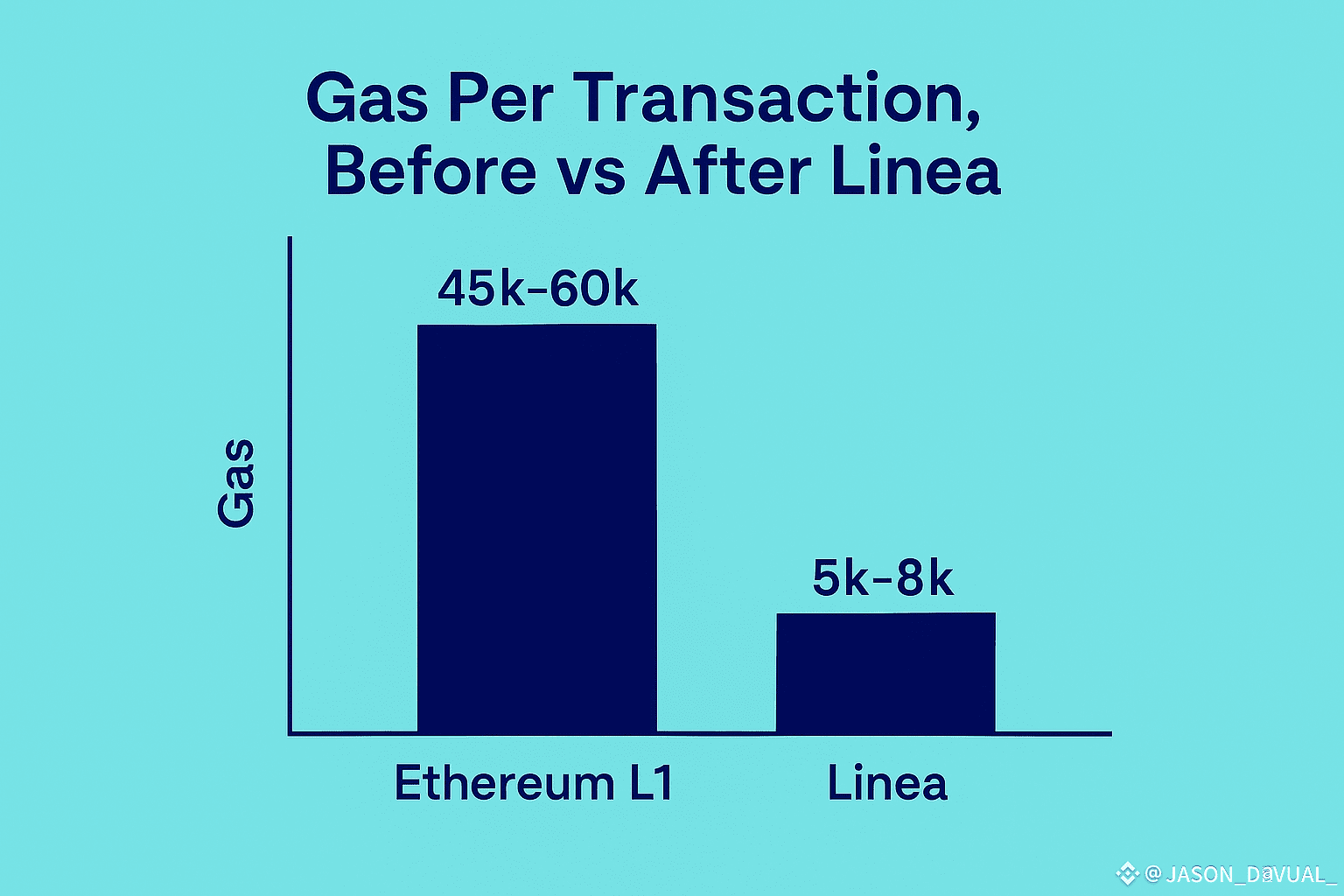
Ethereum’s scaling story has never been about speed alone. It has always been a slow push toward efficiency, toward a network where every transaction becomes lighter while still holding trust. Linea sits inside that moment, not above it. It is a zkEVM rollup built to shrink the computational weight of Ethereum activity, and the clearest place to see the shift is in what people feel first. Gas per transaction. It says a lot about how users sense the chain in motion. You can almost hear that awareness settle in.
Before all of this, people weren’t asking for miracles. They wanted predictable movement and a cost that didn’t sting. And over time the fee itself turned Into a signal. It reflected mood, pressure, congestion. It became cultural in a quiet way. Maybe that is how networks speak when numbers become experience.
Where Ethereum’s Cost Structure Hit a Wall
Before Linea, Ethereum’s average gas per transaction stayed between forty five and sixty thousand units for basic transfers. During heavy activity those numbers jumped sharply, and the rise made simple actions feel expensive for regular users. Data from Etherscan and L2Beat shows that congestion pushed median fees into uncomfortable ranges for small traders and stablecoin users. It marks a pressure point that every chain eventually feels. You can sense the weight of a system stretching.
The deeper problem was architectural. All computation sat on L1. Every proof replicated in full. Contracts executed inside a world shaped for correctness first, not efficiency. And slowly the structure grew heavier than expected. It felt like watching a city outgrow its own streets.
How Linea Rebuilt the Computational Path
Linea approached the issue with compression and verification. Its zkEVM reduces gas per transaction by shifting computation off chain and generating validity proofs, which return as compressed calldata on Ethereum. L2Beat shows that this reduces the effective gas load by more than ninety percent compared to direct L1 execution. It reveals a simple idea. Remove weight and let flow return. There’s beauty in subtraction.
A recent update, Tiered Compression, lowered calldata costs by fifteen to twenty percent across common transactions. It arrived within the last ninety days and stands as one of the network’s quieter yet more meaningful efficiency gains in 2025. It shows a system learning from its own motion. Sometimes progress whispers.
The Numbers Behind Before vs After
Put the two worlds beside each other and the difference becomes structural, not cosmetic.
Ethereum L1 averaged forty five to sixty thousand gas for a transfer.
Linea’s zkEVM often pushes the effective load below five to eight thousand units after proof compression.
And the newest update trimmed close to twenty percent more for frequent operations.
Each number carries a small truth.
The chain feels lighter when friction fades.
DefiLlama reports that Linea’s average fee often sits in the low single digit cents, depending on calldata and activity. The affordability increases usage without creating the sharp spikes that earlier rollups struggled with.
Quiet relief appears inside the data if you look closely.
Numbers fade. Motion stays.
What This Means for Tokenomics and Network Flow
Gas efficiency shapes more than user experience. It forms the economic rhythm of the chain.
Lower gas reduces friction, raises throughput, and increases transaction volume. Linea has seen more than one point five million weekly transactions recently, according to L2Beat. Higher throughput increases proof frequency, which increases L1 calldata submissions, strengthening Ethereum’s base layer without raising user burden.
It hints at a system where volume becomes the quiet engine.
You can feel the design thinking.
The tokenomic effect is patient. Liquidity grows because cost falls, not because incentives are inflated. Optimism and Base rely more visibly on sequencer revenue and MEV extraction. Linea bets on sustained engagement, where lower gas nurtures deeper liquidity and consistent contract activity. It feels like a system choosing balance instead of noise. Maybe that is how infrastructure matures.
Why This Shift Matters in 2025
Scaling competition has sharpened. zkSync is advancing recursion. Polygon is moving toward Type 1 proofs. Starknet is exploring parallelization. Every ecosystem is chasing one outcome. Lower cost per action. The market no longer rewards chains that feel heavy. And you can sense that urgency across narratives.
Stablecoin users, NFT traders, and institutional rails converge on a shared truth. Gas must be low, predictable, and structurally grounded. Linea’s improvements do not shout. They accumulate slowly. Quietly, they hold.
A Closing View on Linea’s Place in the Ecosystem
Study gas usage before and after Linea and you realize you are not studying numbers. You are studying how a network learns to breathe. Ethereum stopped trying to carry every computation itself. Trust moved outward, proofs compressed inward, and the chain felt lighter. It almost feels like architecture learning instinct. A city opening new lanes without changing its map.
Linea is not here to replace the base layer. It is here to make Ethereum feel human again. Lighter, calmer, easier to touch. Lower gas is not an upgrade. It is a shift in posture, a decision to move with intention instead of force. And perhaps that is enough. The proof speaks softly.
🧠 My Personal Thougt
Sometimes the real shift in blockchain isn’t about new features. It is about removing the weight users never wanted to carry. Linea’s drop in gas feels like one of those moments where a network quietly decides to respect people’s time and money. And maybe that is what real scaling should look like.
💬 Mindshare Question
Do you think the future of Ethereum scaling belongs to chains that make transactions lighter, or chains that simply make them faster?
Which one matters more to you when you actually use the network?
